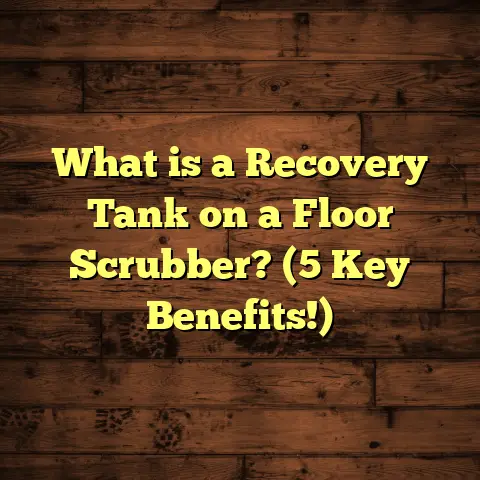What is a Resin Floor? (5 Benefits You Didn’t Know About!)
I’m going to share with you everything I’ve learned about resin flooring—
what it is, why it’s so great, and some benefits you probably never heard of.
If you want a quick but durable flooring fix, resin floors might just be your best bet.
Let’s get into it.
What Is a Resin Floor?
At its core, a resin floor is a type of seamless covering made by applying synthetic resins to a base like concrete.
These resins harden chemically to form a tough, smooth surface that’s resistant to wear and tear.
You won’t find joints or grout lines here—it’s all one continuous sheet, which is ideal for hygiene and maintenance.
The main types of resin floors are:
- Epoxy Resin Floors: These use epoxy polymers mixed with hardeners. When applied, they cure into a rigid plastic-like layer. Epoxy floors are renowned for their strength and chemical resistance.
- Polyurethane (PU) Resin Floors: PU floors are more flexible than epoxy and resist UV light better, so they don’t yellow as much when exposed to sunlight.
- Methyl Methacrylate (MMA) Floors: MMA resin floors dry incredibly fast—even in cold weather—making them a favorite for projects that must finish quickly.
How Resin Floors Are Made and Applied
When I started working with these floors, I was amazed at how much science goes into making them last. Here’s roughly how the process goes:
- Preparation: The existing concrete floor must be thoroughly cleaned and often mechanically abraded (like shot blasting or diamond grinding) to roughen the surface. This ensures the resin bonds well.
- Priming: A primer is applied to seal pores and improve adhesion.
- Base Coat: The main resin layer is poured or troweled on, sometimes mixed with fillers like quartz sand. These fillers add texture and strength.
- Intermediate Layers: Depending on the system, additional coats may be applied for thickness or aesthetic effects.
- Top Coat: Finally, a protective topcoat seals everything in. This topcoat can be clear or pigmented, glossy or matte.
Curing times vary:
- MMA floors can cure in as little as 20 minutes.
- Epoxy floors usually take 12-24 hours to cure fully.
- Polyurethane floors may take slightly longer depending on conditions.
This curing creates a chemical cross-linked network—basically a tight molecular web that gives resin floors their characteristic durability.
The Benefits of Resin Flooring That Surprised Me
I’ve installed floors in all kinds of places—from hospitals to car garages—and every time I’m reminded of why resin floors keep winning my recommendation. Here are five benefits I bet you didn’t know.
1. Speedy Installation Cuts Your Wait Time Dramatically
One of the biggest reasons I love resin floors is how fast they can be installed compared to other flooring types.
For example, hardwood floors take days just to acclimate before installation, plus additional drying time after finishing. Tile floors require grout drying and sealing steps that add days or weeks.
Contrast that with MMA resin floors: I once did a commercial kitchen where the contractor needed the floor ready overnight. MMA resin cured fully within two hours, letting the kitchen reopen the next morning without delay.
This speed means:
- Less business downtime
- Faster project turnover
- Lower labor costs because crews aren’t tied up for days
Even epoxy floors, which take longer than MMA, still beat many traditional floors by curing in about a day instead of multiple.
2. Durability That Lasts Years Without Repair
Resin floors don’t just look good right after installation—they keep performing for years.
Epoxy resin floors have compressive strengths over 70 MPa (megapascals), far exceeding typical concrete slabs that range around 20-40 MPa. This means resin floors can handle heavy machinery, forklift traffic, and even dropped tools without cracking.
Years ago, I worked on a warehouse floor replacement project for a logistics company. Their old concrete surface was riddled with cracks from forklift use. After we applied an epoxy resin system with quartz aggregate for extra grip, their floor showed no signs of wear even five years later.
This strength reduces maintenance costs drastically since you’re not fixing cracks or chips every few months.
3. Chemical Resistance Keeps Floors Looking Clean
Have you ever spilled oil or cleaning chemicals on your floor and struggled to remove stains? Resin floors solve this problem.
Because they’re non-porous and chemically resistant, spills don’t soak in or cause discoloration. Epoxy floors resist many acids, solvents, oils, and alkalis.
I remember helping an automotive shop switch from vinyl tiles to epoxy resin flooring. Brake fluid spills and paint thinner accidents were part of daily life there. After switching, cleanup was as simple as wiping with a rag—no stains left behind.
In environments like labs or hospitals where cleanliness is critical, this resistance also prevents microbial growth.
4. Aesthetic Flexibility—Design Your Floor Your Way
Resin floors aren’t just functional—they can be beautiful too.
I once worked with a boutique retail store owner who wanted their floor to reflect their brand colors without breaking the bank on custom tiles. Adding colored pigments and flakes into epoxy resin gave them a unique speckled floor that matched their logo perfectly.
You can choose:
- Solid colors
- Multicolor flakes or chips for texture
- Metallic finishes that shimmer subtly
- Matte or glossy topcoats
Anti-slip additives mix easily into coatings without ruining appearance or smoothness. This gives safety benefits in wet areas like kitchens or hospitals without sacrificing style.
5. Long-Term Cost Efficiency That Surprises Many
I’m often asked if resin floors are “worth it” given their upfront cost versus cheaper options like vinyl or linoleum.
Here’s what my experience and research show:
- Resin floors typically last 10–15 years before needing major refurbishment.
- Over this lifespan, maintenance costs average 40% lower than vinyl or linoleum floors.
- Fast installation reduces indirect costs like lost business days.
- Fewer repairs mean less labor expense over time.
A case study from a manufacturing plant I worked on quantified this: Switching from painted concrete to epoxy resin flooring saved the company an estimated $15,000 annually in maintenance and downtime costs.
A Bit More About the Science Behind Resin Floors
Understanding why these floors perform so well means looking deeper into their chemical makeup and manufacturing process.
Epoxy Resin Chemistry
Epoxy resins are made from molecules called epoxides that react chemically with hardeners (curing agents). This reaction forms cross-links—strong bonds connecting polymer chains into a solid network.
This is what gives epoxy its:
- High mechanical strength
- Excellent adhesion to concrete
- Resistance to chemical attack
Fillers like quartz sand added during mixing increase hardness and provide texture for grip.
Polyurethane Resin Properties
Polyurethane resins are formed by reacting polyols with isocyanates.
They create flexible but tough coatings that bend slightly under pressure without cracking.
PU resins also resist UV degradation well—important if your floor gets sunlight exposure.
Methyl Methacrylate (MMA) Chemistry
MMA is a fast-curing thermoplastic polymer formed by radical polymerization of methyl methacrylate monomers.
Its low molecular weight means it cures rapidly at room temperature—even in cold weather—making it ideal when speed is essential.
Challenges You Might Face With Resin Floors (And How I Handle Them)
No product is perfect, so here are some things I’ve learned you should watch out for:
Surface Preparation Is Key
Poor surface prep leads to delamination (floor peeling up).
I’ve seen projects fail because contractors didn’t remove oil stains or dust properly before applying resin.
That’s why I spend extra time on cleaning and mechanical abrasion before any resin hits the floor.
Temperature Sensitivity During Installation
Resin curing depends heavily on temperature and humidity.
For example:
- Epoxy resins cure poorly below 10°C (50°F).
- MMA cures well even at low temps but has strong fumes requiring ventilation.
Knowing these limits helps me schedule jobs correctly and choose materials suited to site conditions.
Cost Can Be Higher Initially
Resin floors aren’t cheap upfront—but they pay off over time as I mentioned earlier.
To help clients budget realistically, I use tools like FloorTally that consolidate material prices, labor rates, waste factors, and more into accurate estimates quickly. This way we avoid surprises later on.
More Real Stories From My Floor Installations
I want to share some real projects that highlight resin flooring benefits in action:
Hospital Operating Room Upgrade
A hospital needed a new floor that would withstand harsh cleaning chemicals yet remain sterile and safe for staff and patients.
We installed an epoxy resin floor with antimicrobial additives and anti-slip texture. It cured in 24 hours allowing operations to continue without long closure periods.
One year later, hospital staff reported fewer slip incidents and easier cleaning routines—a major win for everyone involved.
Boutique Retail Store Floor Makeover
The boutique wanted something modern but easy to maintain. We created an epoxy floor embedded with colored flakes matching their brand colors plus a matte finish for subtle elegance.
Customer feedback was fantastic—they loved how unique the floor looked without feeling cold or industrial.
Industrial Warehouse Reinforcement
A logistics company’s high-traffic warehouse needed repair after years of forklift damage on concrete slabs.
We shot blasted the surface and applied multi-layer epoxy with quartz aggregate topcoat for durability and grip. The floor lasted over five years without repairs—saving the client thousands compared to previous patch jobs.
Cost Breakdown: What Factors Influence Resin Floor Pricing?
If you’re curious about what drives costs up or down when choosing resin floors, here’s what I look at:
| Factor | Effect on Cost |
|---|---|
| Floor Area | Larger areas require more materials & labor |
| Surface Condition | Repairing cracks or leveling adds prep time |
| Resin Type | MMA > PU > Epoxy in cost order (fastest usually costs more) |
| Thickness | Thicker layers need more material & labor |
| Additives | Anti-slip granules or antimicrobial agents increase price |
| Site Accessibility | Hard-to-reach areas increase labor costs |
| Local Labor Rates | Varies by region; affects total project price |
Using FloorTally helps me plug in all these variables for precise quotes based on local suppliers and wage data—huge help when managing multiple projects or negotiating with clients.
Maintenance Tips To Keep Resin Floors Looking New
Even though resin floors are low maintenance compared to other types, here’s what I always recommend:
- Clean spills immediately to prevent buildup—even though stains rarely penetrate.
- Use neutral pH cleaners; avoid harsh abrasives that can damage the topcoat.
- Regularly check for scratches or chips; minor repairs extend floor life.
- For high traffic areas, consider reapplying topcoat every few years as part of preventive care.
In one office building I worked on, regular scheduled cleaning kept their epoxy floors shiny over seven years with no need for major repairs.
Frequently Asked Questions About Resin Floors
Q: Can resin floors be installed over existing tiles?
A: Generally not recommended due to poor bonding risk. Better to remove tiles first for best results.
Q: Are resin floors slippery when wet?
A: Without anti-slip additives they can be slick; however adding quartz granules or textured finishes improves grip significantly.
Q: How long do resin floors last?
A: Typically 10–15 years depending on wear conditions and maintenance habits.
Q: Can I do DIY resin flooring?
A: Small repairs maybe—but full installations require professional surface prep and mixing accuracy for durable results.
Final Thoughts (No Fancy Wrap-Up)
If you need fast installation combined with longevity, durability, ease of cleaning, chemical resistance, and design freedom—resin flooring deserves your attention.
I’ve seen it transform spaces from dull warehouses to sleek retail stores while saving time and money down the road.
And if budgeting feels overwhelming? Tools like FloorTally make estimating materials and labor simple so you can plan smartly instead of guessing.
Got questions? Or want me to help figure out if resin flooring fits your project? Just ask—I’m happy to share what I’ve learned firsthand!





